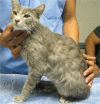Feline demodicosis: a consideration in the itchy or overgrooming cat
- PMID: 22370863
- PMCID: PMC10822434
- DOI: 10.1177/1098612X12439268
Feline demodicosis: a consideration in the itchy or overgrooming cat
Abstract
Practical relevance: In cats, three species of demodex mites have been identified as causes of demodicosis, which may manifest as pruritus, miliary dermatitis and/or self-induced alopecia. The condition has been recognized in various countries but does seem to show regional preferences.
Clinical challenges: Diagnosis of feline demodicosis can be a challenge as mites are not always readily found within scrapings of the skin examined microscopically. One or more species of demodex mite may be involved in an infestation. Furthermore, the condition can be difficult to treat effectively.
Audience: This review is intended as a clinical update for veterinary surgeons in practice who rarely encounter demodicosis.
Conflict of interest statement
The author declares that there is no conflict of interest.
Figures






Similar articles
-
Feline demodicosis caused by concurrent infestation with Demodex cati and an unnamed species of mite.Vet Rec. 2005 Sep 3;157(10):290-2. doi: 10.1136/vr.157.10.290. Vet Rec. 2005. PMID: 16157572 No abstract available.
-
Five observations of a third morphologically distinct feline Demodex mite.Vet Dermatol. 2013 Aug;24(4):460-2, e106. doi: 10.1111/vde.12028. Epub 2013 Apr 29. Vet Dermatol. 2013. PMID: 23627423
-
Demodex gatoi-associated contagious pruritic dermatosis in cats--a report from six households in Finland.Acta Vet Scand. 2009 Oct 20;51(1):40. doi: 10.1186/1751-0147-51-40. Acta Vet Scand. 2009. PMID: 19843334 Free PMC article.
-
Diagnosis and treatment of demodicosis in dogs and cats: Clinical consensus guidelines of the World Association for Veterinary Dermatology.Vet Dermatol. 2020 Feb;31(1):5-27. doi: 10.1111/vde.12806. Vet Dermatol. 2020. PMID: 31957202 Review.
-
[Evidence-based treatment of canine demodicosis].Tierarztl Prax Ausg K Kleintiere Heimtiere. 2011;39(6):419-24. Tierarztl Prax Ausg K Kleintiere Heimtiere. 2011. PMID: 22167167 Review. German.
Cited by
-
Successful treatment of otodemodicosis due to Demodex cati with sarolaner/selamectin topical solution in a cat.JFMS Open Rep. 2021 Jan 28;7(1):2055116920984386. doi: 10.1177/2055116920984386. eCollection 2021 Jan-Jun. JFMS Open Rep. 2021. PMID: 33598306 Free PMC article.
-
Demodex musculi Infestation in Genetically Immunomodulated Mice.Comp Med. 2016;66(4):278-85. Comp Med. 2016. PMID: 27538858 Free PMC article.
-
Feline Demodicosis Case Report-First Molecular Characterization of Demodex Mites in Romania.Pathogens. 2021 Nov 12;10(11):1474. doi: 10.3390/pathogens10111474. Pathogens. 2021. PMID: 34832631 Free PMC article.
-
Effectiveness of a fluralaner spot-on formulation in a case of feline demodicosis due to Demodex cati.JFMS Open Rep. 2022 Jan 27;8(1):20551169211069529. doi: 10.1177/20551169211069529. eCollection 2022 Jan-Jun. JFMS Open Rep. 2022. PMID: 35111330 Free PMC article.
-
Comparison of parasitic mite retrieval methods in a population of community cats.J Feline Med Surg. 2017 Jun;19(6):657-664. doi: 10.1177/1098612X16650717. Epub 2016 Jun 3. J Feline Med Surg. 2017. PMID: 27259538 Free PMC article.
References
-
- Kwochka KW. Demodicosis. In: Griffin CE, Kwochka KW, MacDonald JM. (eds). Current veterinary dermatology. St Louis: Mosby Year Book, 1993, pp 72–84.
-
- Neel JA, Tarigo J, Tater KC, Grindem CB. Deep and superficial skin scrapings from a feline immunodeficiency virus-positive cat. Vet Clin Pathol 2007; 36: 101–104. - PubMed
-
- Lowenstein C, Beck W, Bessmann K, Mueller RS. Feline demodicosis caused by concurrent infestation with Demodex cati and an unnamed species of mite. Vet Rec 2005; 157: 290–292. - PubMed
-
- Morris DO, Beale KM. Demodicosis. In: August JR. (ed). Consultations in feline internal medicine. Vol 5. St Louis, MO: Elsevier Saunders, 2006, pp 247–250.
Publication types
MeSH terms
LinkOut - more resources
Full Text Sources
Miscellaneous

